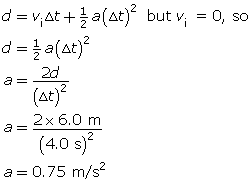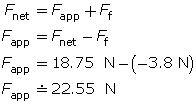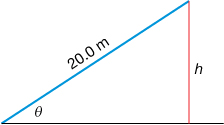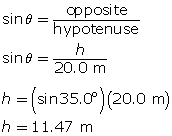Module 6—Work and Energy
 Module 6: Lesson 1 Assignment
Module 6: Lesson 1 Assignment
Remember to submit the answers to TR 1, TR 2, TR 3, and TR 4 to your teacher as part of your Module 6: Lesson 1 Assignment.
 Try This
Try This
TR 1. A 2.20-N object is held 2.20 m above the floor for 10.0 s. How much work is done on the object?
TR 2. A 60.0-kg student runs at a constant velocity up a flight of stairs. If the vertical distance of the stairs is 3.2 m, what is the work done against gravity?
Hint: Use the formula Fg = mg.
TR 3. A 10.0-kg object is accelerated horizontally from rest to a velocity of 11.0 m/s in 5.00 s by a horizontal force. How much work is done on this object?
Hint: Use the following formula:
![]()
TR 4. A 90.0-N box is pulled 10.0 m along a level surface by a rope. If the rope makes an angle of 20.0° with the surface, and the force exerted through the rope is 75.0 N, how much work is done on the box?
 Self-Check
Self-Check
SC 1. A 25.0-kg object is accelerated from rest through a distance of 6.0 m across a level floor in 4.0 s. If the force due to friction between the object and the floor is 3.8 N, what is the work done in moving the object? (Note: Fnet = ma, where a is the observed acceleration and Fnet = Fapp + Ff, where Ff is in the opposite direction of Fapp.)
 Self-Check Answers
Self-Check Answers
SC 1.
Given
m = 25.0 kg d = 6.0 m t = 4.0 s Ff = 3.8 N
Required
the work done in moving the object (W)
Analysis and Solution
The applied force will be the force to accelerate the object plus the force to overcome friction. The acceleration is calculated as follows:

The net force can be calculated as follows:

The applied force is calculated as follows:

The work done is calculated as follows:

Paraphrase
There was 1.4 × 102 J of work done in moving the object.
When a bungee jumper is lifted at constant velocity via a crane platform, work is done against gravity, causing the jumper to have a given height relative to the ground below. In such a case, the lifting force applied to the jumper opposes his or her weight. Substituting weight (Fg) and vertical displacement (h) into the work equation produces a new equation for describing the work done in lifting an object against Earth’s gravitational field.
work = force × displacement
work = weight × vertical displacement
W = mgΔh
It is commonly accepted that if the object is lifted from the ground to a given height, the equation may be written as W = mgh. However, care should be taken to ensure that it is the change in height that is substituted into the equation.
gravitational potential energy: the energy of an object due to its height above Earth
Expressed as an equation, it is
Ep = mgh
Assuming that all of the work is done on the object being lifted vertically, the object gains an equal amount of gravitational potential energy. Therefore,
gain in potential energy = work done to lift it
Ep = mgΔh (or Ep = mgh, where h is the change in height)
| Quantity | Symbol | SI Unit |
| gravitational potential energy | Ep | J |
| mass | m | kg |
| acceleration due to gravity | g | m/s2 |
| height | h | m |
1 J is equal to 1 N•m. Energy is a scalar quantity.
Gravitational potential energy is one form of potential energy involved in the bungee jumper-and-cord system. A second form of energy, called elastic potential energy, is also involved.
 Read
Read
Read about gravitational potential energy on pages 295 and 296 of your textbook.
 Self-Check
Self-Check
SC 2. Solve question 1 of “Practice Problems” on page 296 of your textbook.
 Self-Check Answers
Self-Check Answers
SC 2.
Given
me = 750 kg
m1 = 65.0 kg
m2 = 30.0 kg
m3 = 48.0 kg
h = −21.0 m
Required
the change in gravitational potential energy (ΔEp)
Analysis and Solution
Find the total mass of the elevator and the three people. Use the formula for change in gravitational potential energy to find the required answer.
mt = 750 kg + 65.0 kg + 30.0 kg + 48.0 kg
mt = 893 kg
ΔEp = mgΔh
ΔEp = (893 kg)(9.81 m/s2)( −21.0 m)
ΔEp = −1.84 × 105 J
Paraphrase
The change in gravitational potential energy of the car and its passengers is
−1.84 × 105 J.
 Read
Read
Read about the importance of the reference point used on pages 297 and 298 of your textbook.
 Self-Check
Self-Check
SC 3. Solve question 3 of “Practice Problems” on page 298 of your textbook.
 Self-Check Answers
Self-Check Answers
SC 3.
Given
m = 250 kg
Δd = 20.0 m
θ = 35.0°
Required
the change in potential energy (ΔEp)
Analysis and Solution

Choose the height of the bottom of the incline as the reference point. Find the height of the incline, and use the gravitational potential energy formula.


Paraphrase
The change in potential energy is 2.81 × 104 J.